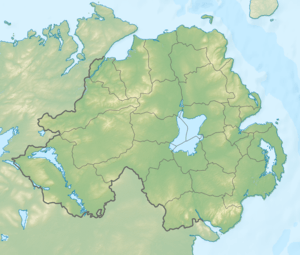Newtownhamilton bombing
| Newtownhamilton bombing | |
|---|---|
| Part of the Troubles | |
 | |
| Location | Newtownhamilton, County Armagh, Northern Ireland |
| Coordinates | 55°02′28″N 7°00′36″W / 55.041°N 7.010°WCoordinates: 55°02′28″N 7°00′36″W / 55.041°N 7.010°W |
| Date |
24 June 1998 14:20 (GMT) |
Attack type | Bombing |
| Weapons |
Time bomb Car Bomb |
| Deaths | 0 |
Non-fatal injuries | 6 |
| Perpetrator | Irish National Liberation Army (INLA) |
Suspected perpetrator | helped by Real IRA |
The Newtownhamilton bombing was a carbombing carried out by the Irish National Liberation Army (INLA) on the 24 June 1998 in the Armagh border village of Newtownhamilton shortly after the signing of the 1998 Good Friday Agreement by the Irish government, British government Nationalist and Unionist parties as well as parties which represented Republican and Loyalist paramilitaries. The INLA and its political wing the IRSP were opposed to the agreement. The bombing was one of the last actions carried out or claimed by the INLA during the 30 year conflict known as the Troubles
Background
The Good Friday Agreement was signed on the 10 April 1998 and was approved by most major paramilitaries on the Republican and Loyalist sides of the conflict like the Provisional IRA (PIRA) and the Ulster Volunteer Force (UVF) but was opposed by smaller dissident groups on each side like the Real IRA (RIRA, formed in 1997 after splitting with the PIRA), the Loyalist Volunteer Force (formed in 1996 after splitting with the UVF) and the INLA itself.
The INLA was formed in 1974 and started to wage a paramilitary campaign against the British state and military soon afterwards. The group became a formidable military force in the late 1970s, it gained large scale support and a large number of young recruits after the 1981 Hunger Strikes in which three INLA Volunteers died. The Supergrass trials of the mid-1980s weakened the group and a feud with the newly formed Irish People's Liberation Organisation almost dealt the INLA a fatal blow. The group re-launched its campaign some what in 1992 with two attacks in England, several bombings in Leeds and the shooting dead of British soldier, Michael Newman in Derby. In June 1994 (the group's most active year since the mid-1980s) an INLA active service unit ambushed and shot dead 3 high ranking UVF members on the Shankill Road just outside the UVF's HQ. An internal INLA feud in 1996 left six people dead including the groups Chief of Staff Gino Gallagher and several others injured. In 1997 in one of the most controversial incidents of the conflict three INLA Volunteers shot dead LVF leader Billy Wright from inside the Maze prison. After killing Wright, the three Volunteers handed themselves over to prison guards. They also handed over a statement, which read: "Billy Wright was executed for one reason and one reason only, and that was for directing and waging his campaign of terror against the nationalist people from his prison cell in Long Kesh." After a string of attacks on Catholic civilians by the LVF after the Wright shooting in which UDA members were believed to be involved the INLA shot dead UDA leader Jim Guiney at his carpet shop in Dunmurry on 19 January 1998.
The Bombing
The car bomb attack took place during a time of high activity by dissident Irish Republicans especially by the Real IRA and Continuity IRA mainly in protest at the Good Friday Agreement which dissidents argued was a document of surrender to the British government, Sinn Fein argued it was a huge stepping stone to a United Ireland and that the armed struggle had gone as far as it could go and further loss of life was pointless and immoral.
The car bomb exploded in the predominantly Catholic border town of Newtownhamilton close to a polling station, injuring six people including a 15-year-old boy despite the INLA giving a 50-minute warning as police were still trying to evacuate people from the bomb area. The bomb was estimated to have weighed 200 lbs and along with the injured it caused widespread damage. The financial damage from the attack was estimated at £2 million.[1] Police believed the Real IRA supplied the INLA with Semtex commercial explosive which was thought to have been used as a component in making the bomb.[2] The bombing was seen as a "protest attack" as it happened the day before Northern Ireland Assembly Elections took place on the 25 June 1998.[3] The INLA was not against a peace process but was against certain parts of the Good Friday Agreement as they believed it did nothing to rid Northern Ireland of sectarianism which they viewed as a major obstacle to achieving a Democratic Socialist Irish Republic.
Aftermath
Two months later on 15 August the Omagh bombing[4] caused by the Real IRA killed almost 30 people and injured over 250 more. The shock and outrage in Ireland and Britain over the human cost of the bomb was such that the Real IRA soon called a ceasefire[5] and so did the INLA on the 22 August 1998[6] bringing an end to their 24-year paramilitary campaign which killed over 100 people and injured hundreds more. Almost a year later on the 8 August 1999 the INLA issued a statement saying: "There is no political or moral argument to justify a resumption of the campaign."
See also
References
- ↑ "Bomb damage in village put at £2m".
- ↑ Melaugh, Dr Martin. "CAIN: Chronology of the Conflict 1998".
- ↑ Melaugh, Dr Martin. "CAIN: Issue: Politics: Elections: Assembly Election (NI) Thursday 25 June 1998".
- ↑ Sutton, Malcolm. "CAIN: Sutton Index of Deaths".
- ↑ Melaugh, Dr Martin. "CAIN: Events: Peace Process: "real" IRA statement 2, 18 August 1998".
- ↑ Melaugh, Dr Martin. "CAIN: Events: Peace: Ceasefire Statement issued by the Irish National Liberation Army (INLA), Saturday 22 August 1998".